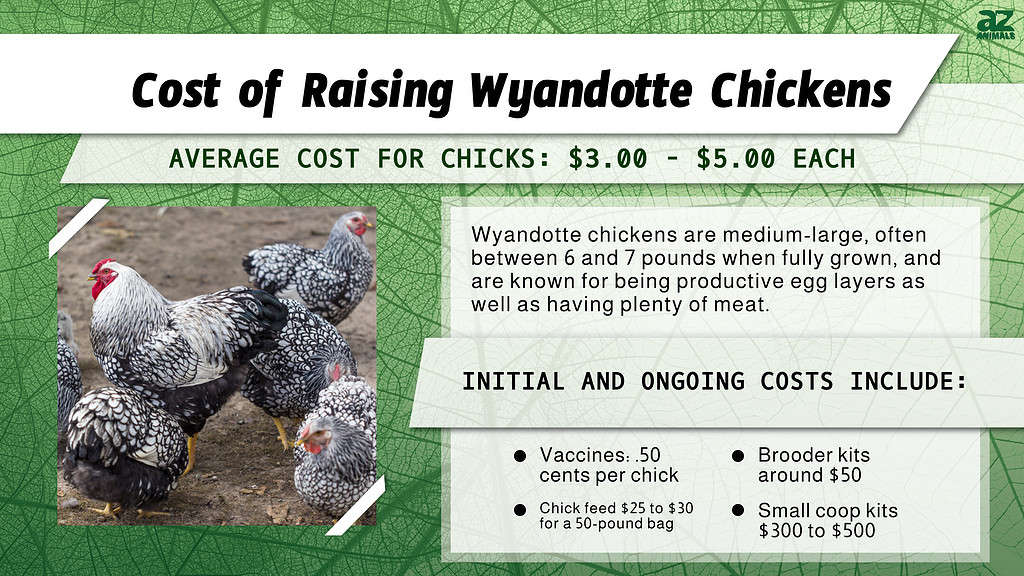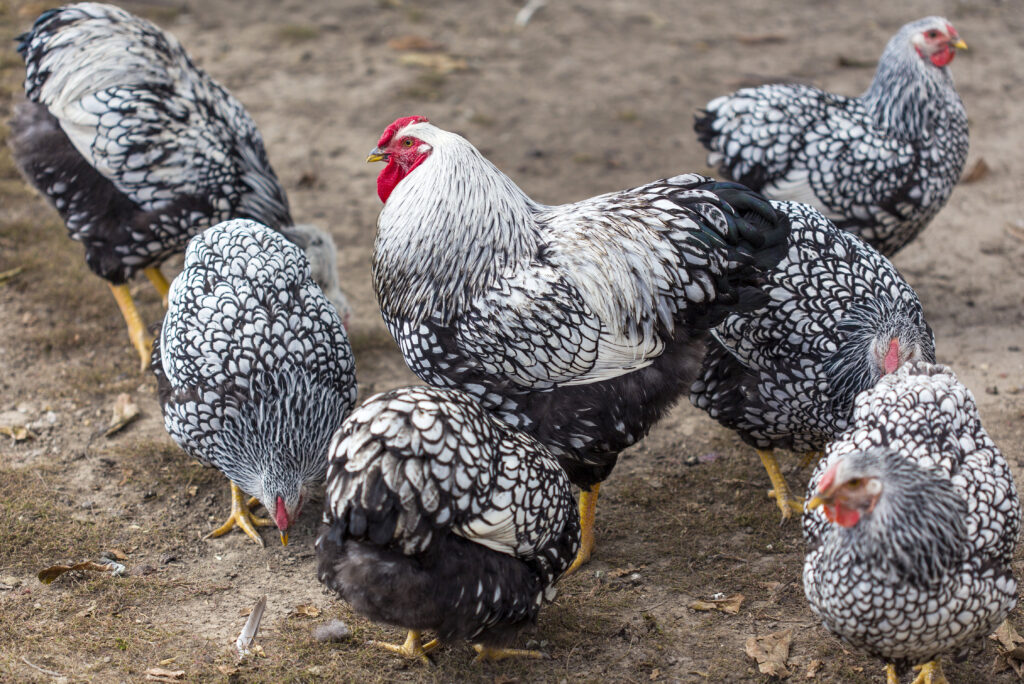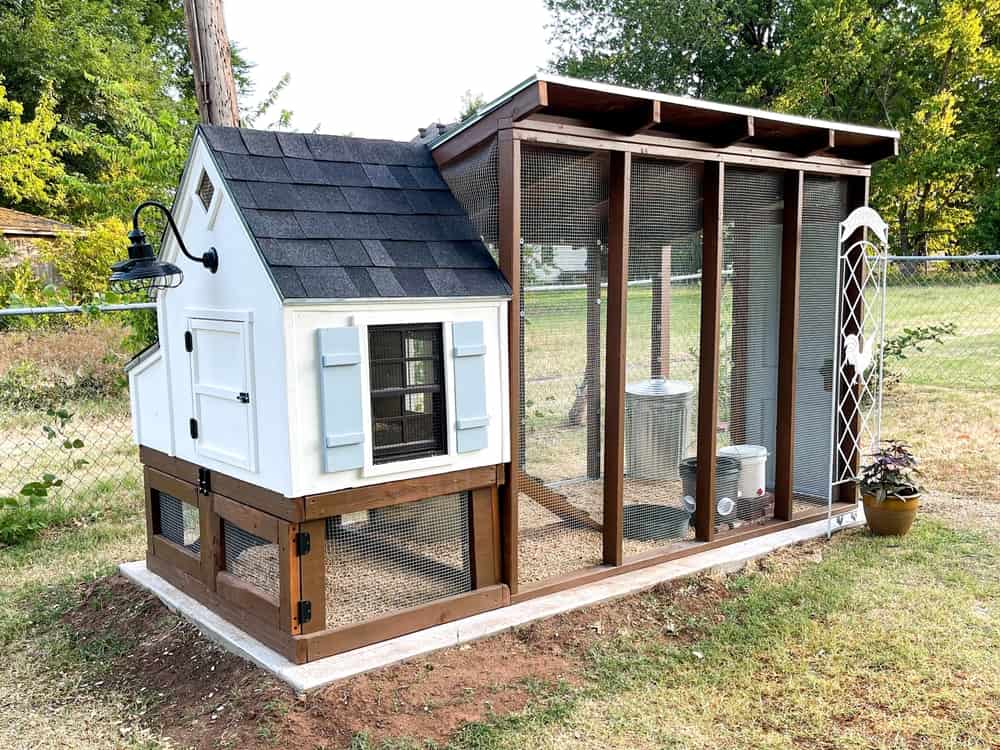Thinking about adding a Wyandotte chicken to your flock? These birds make excellent egg layers as well as chickens kept for meat. They get along well with others and are also just fun to watch. Getting chickens or adding to your existing flock is a financial commitment, so it’s helpful to know what costs to expect. You should take a few things into account before adding chickens to your family either as a pet or livestock, including the costs to get the chicks, the required equipment to care for them, and the ongoing costs of food and a chicken coop.

Purchasing Wyandotte Chickens

Distinguishing the Wyandotte hen vs.
rooster
can be challenging because they have similar plumage.
©Don Pablo/Shutterstock.com
When deciding to add Wyandotte chickens to your flock or start a new flock, it’s important to understand the lingo. Wyandotte refers to the actual breed of chicken. They are recognizable by their black and white laced feathers. They tend to be mild-mannered and get along with other chickens of all breeds. Wyandottes are known for being productive egg layers. They also have plenty of meat. They are medium-large, often between 6 and 7 pounds when fully grown. All of these characteristics make them good chickens for backyard flocks, even for beginners.
When purchasing chickens of any breed, most reputable places require you to purchase multiple at once. This is mainly because chickens are birds that live in flocks. They are not meant to live alone and can suffer from numerous health issues when not part of a flock. Expect to have a minimum number to purchase, often around 5. This may not be the case when purchasing Wyandotte roosters to add to your flock. When purchasing chicks, you can choose between females, males, and straight run. Straight run means that the sex is not known and you get a random assortment of chicks.
If you purchase between 1 and 5 Wyandottes, they are typically between $3.00 and $5.00 per chick. Males cost the least, straight runs are in the middle, and females cost the most. If you buy a larger quantity, the cost per chick goes down to as little as $2.00. You can buy chicks in quantities of up to 100 or more.
What do Wyandotte chicks look like?
Like most chicks, Wyandotte chicks have soft, downy fluff. As they grow, their adult feathers come in. They tend to be darker with yellow, orange, or white undertones. Their coloring as chicks resembles their coloring as adults, although they do not yet have the lacey feather pattern. This happens as their adult feathers develop.
Wyandotte Supplies

There are a few supplies that you’ll need if raising chicks for the first time. Some can be reused for future chicks and some are specific to each batch. Wyandotte chicks do not need any specialized equipment compared to other chicks. So, if you have already raised other breeds, you can likely use the same equipment and setup for your new Wyandottes as long as they remain in good repair.
Consider vaccines for your chicks. Some hatcheries will offer this as an add-on to your initial purchase. A vaccine against Marek’s disease is the most common and should be given to the chicks as soon as they hatch. This can add to the initial cost per chick, typically by less than 50 cents each. You can also talk to your vet about other vaccines, checkups, or health care that your chicks should get. They can also give you a good idea of ongoing medical care or expenses.
You’ll also need a brooder to provide a safe place for your chicks to grow and mature. Chicks need access to a heat lamp, soft bedding underfoot, and chick-friendly places to eat and drink. As they get bigger, you can provide them with more room and access in the brooder. Once they have all of their feathers and can keep themselves warm, they can transition from the brooder to a larger coop or run. Brooders can be purchased in kits for around $50, although a larger flock will need a larger brooder or multiple setups. You can also DIY a brooder by assembling the components yourself.
Chicken Feed

Ideally, each chick has their own place to eat chicken feed in a brooder on a farm.
©iStock.com/Jennifer Chamblee
Your new chicks will need to eat pretty soon so make sure that you have the appropriate feed available. Chick feed is specially made for this stage of growth and development. It has a balance of protein and other ingredients to provide the right nutrition. Most also include probiotics and prebiotics to help with gut health and the immune system. Herbs such as oregano are commonly added to help promote a healthy immune system as well. Expect to pay between $25 and $30 for a 50-pound bag. Organic or specialty brands can be as much as three times that much.
You can also get special supplements, such as probiotics, vitamins, and electrolytes. You can get a water-soluble formula to add to their drinking water or a gel that you feed directly to the chicks. These typically cost between $4.00 and $10.00 for a supply for the entire flock, although you can find more expensive options as well.
Once they mature, Wyandotte chicks can graduate to an adult chicken feed. Depending on the nutritional needs of your birds, you can go for a standard chicken feed or something meant to target specific needs, such as a healthy feather blend or one made for egg layers. Some feeds come in pellets while others are more granular or gritty. Adult chicken feed often costs between $10 and $12 for a 10-pound bag. Buying in bulk can cut down on the per-pound cost, although you’ll need a place to keep the extra feed.
Setting Up a Coop

The best chicken coops are easy to clean and provide plenty of space for your chickens to explore while enjoying protection from predators and the elements.
©Courtney Jenckes/Shutterstock.com
Eventually, your new chicks will grow and need a larger space. This is where a chicken coop becomes a necessity. You don’t need a ton of space but should have enough room outdoors for your flock to move around, explore, and take shelter. A good chicken coop has space for the chickens to roost off the ground, even if it is a small shelf or perch just off the ground. Many have multiple floors, which might be required for a larger flock. It should also provide protection from potential predators, such as foxes. You should also consider how accessible the interior is so that you can get to any eggs that your chickens lay as well as clean it when it needs that.
Small coop kits typically cost between $300 and $500. These are often more bare bones and don’t include a larger run attached. If you want or need to get something larger, expect to pay around $800 to $1200. Pay close attention to the recommended capacity for each coop, since crowding your chickens can be very bad for their health. You can also build your own coop and run, which can significantly cut down on the cost. You might need a few tools and some know-how, but DIY chicken coop plans and tips are available online.
If you want to have eggs hatch, Wyandottes are a good chicken to have around. This breed has a tendency to go broody. This means that they will sit on and incubate eggs until they hatch, even if they are not eggs that they lay. Keep in mind that this does require the hens to have access to a rooster to fertilize the eggs. Otherwise, they will lay eggs that are not fertilized. These can be eaten rather than hatched, another good option for those who keep Wyandottes.
The photo featured at the top of this post is © Nick Beer/Shutterstock.com
Thank you for reading! Have some feedback for us? Contact the AZ Animals editorial team.







